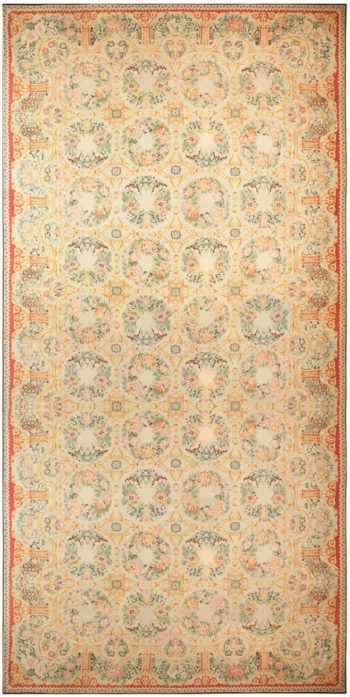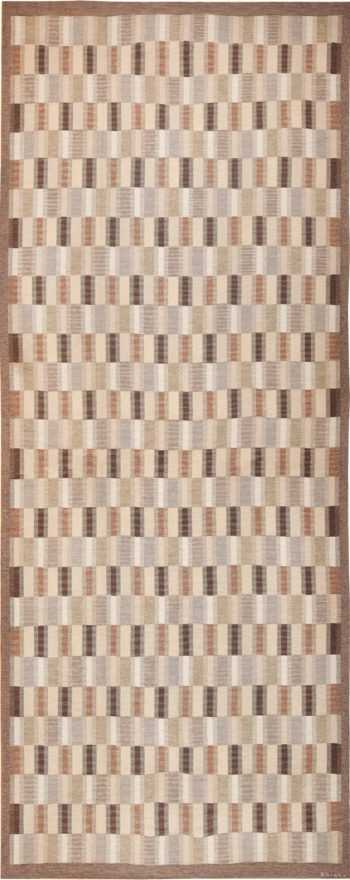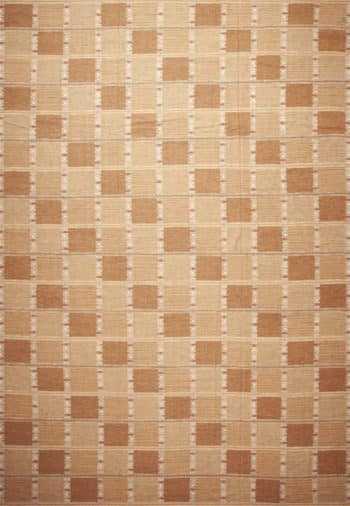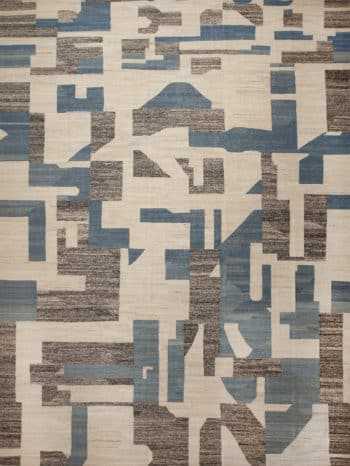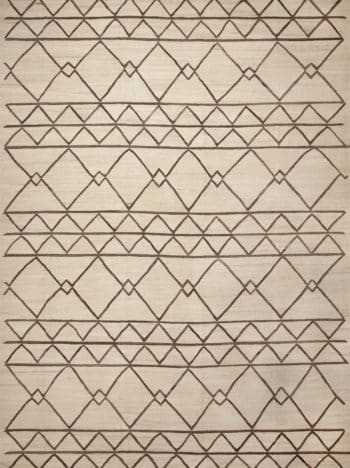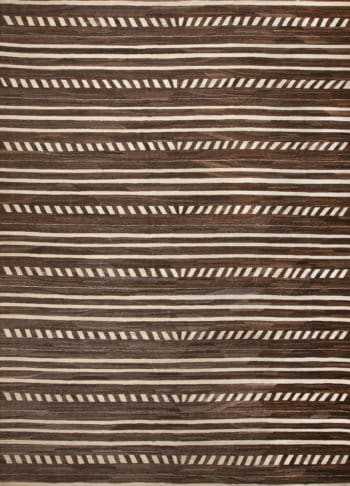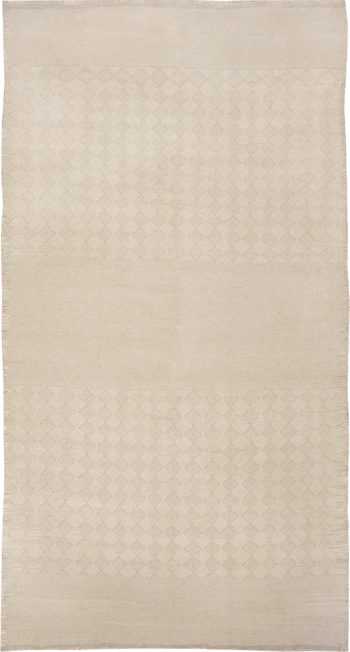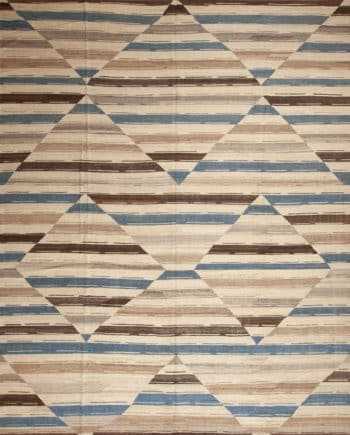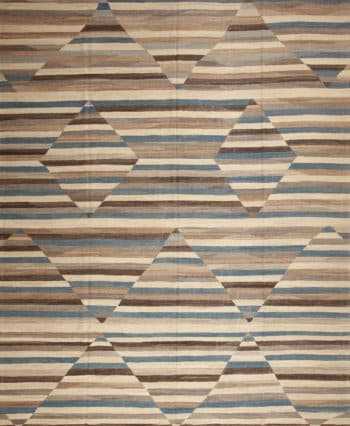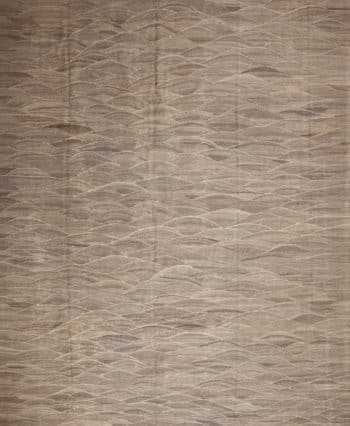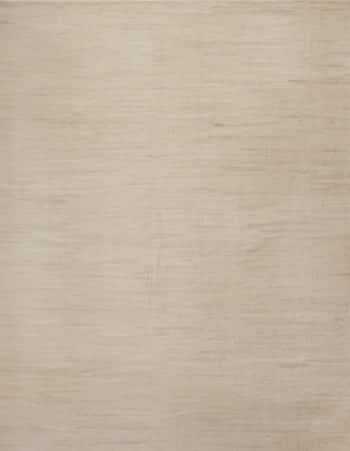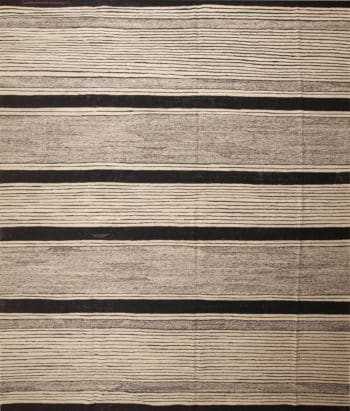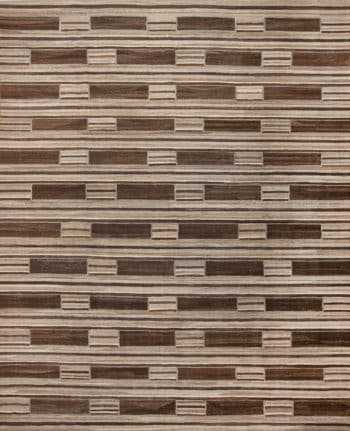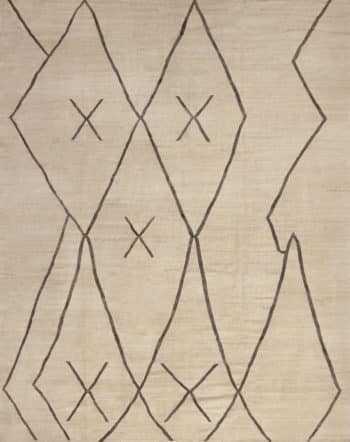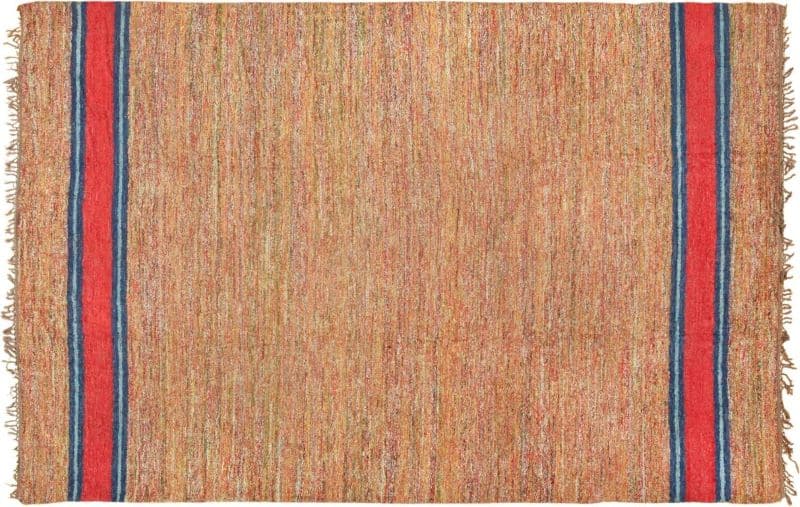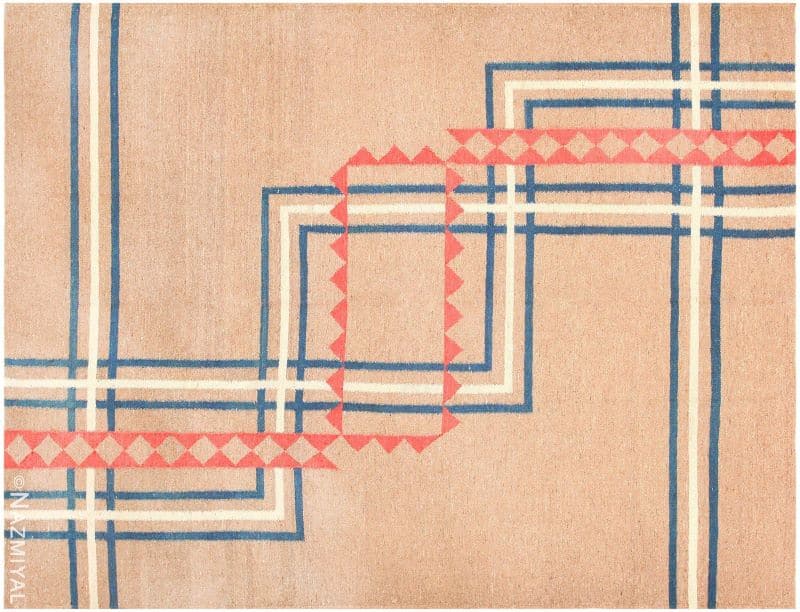View our selection of antique flat woven Kilims and Kilim rugs:
Antique Oversize Floral Romanian Bessarabian Kilim Rug 70101
$145,000.00Size: 17 ft 5 in x 34 ft (5.31 m x 10.36 m)Vintage Oversize Scandinavian Brita Grahn Kilim Rug 49804
$66,000.00Size: 11 ft 8 in x 28 ft 10 in (3.56 m x 8.79 m)Neutral Earthy Long and Narrow Modern Hallway Flatweave Runner Kilim Rug 11003
Original price was: $4,400.00.$3,080.00Current price is: $3,080.00.Size: 4 ft 5 in x 20 ft (1.35 m x 6.1 m)Modern Large Size Flatweave Mid Century Swedish Design Kilim Rug 72646
Original price was: $15,900.00.$11,130.00Current price is: $11,130.00.Size: 13 ft 5 in x 19 ft 9 in (4.09 m x 6.02 m)Large Modern Contemporary Flat Woven Brown Geometric Kilim Area Rug 11838
Original price was: $13,550.00.$9,485.00Current price is: $9,485.00.Size: 14 ft 4 in x 19 ft 5 in (4.37 m x 5.92 m)Artistic Abstract Geometric Large Flat Weave Modern Contemporary Kilim Rug 11840
Original price was: $13,850.00.$9,695.00Current price is: $9,695.00.Size: 14 ft 4 in x 19 ft 5 in (4.37 m x 5.92 m)Grey Geometric Tribal Deign Large Size Modern Flatweave Kilim Rug 11839
Original price was: $13,700.00.$9,590.00Current price is: $9,590.00.Size: 14 ft 4 in x 19 ft 1 in (4.37 m x 5.82 m)Grey Cream Modern Contemporary Flat Woven Geometric Kilim Rug 11811
Original price was: $12,550.00.$8,785.00Current price is: $8,785.00.Size: 13 ft 3 in x 19 ft 1 in (4.04 m x 5.82 m)Large Flatweave Geometric Mid Century Modern Design Kilim Area Rug 11810
Original price was: $15,000.00.$10,500.00Current price is: $10,500.00.Size: 13 ft 2 in x 19 ft (4.01 m x 5.79 m)Large Size Geometric Contemporary Vintage Mid-Century Modern Design Flatweave Kilim Rug 11813
Original price was: $12,790.00.$8,953.00Current price is: $8,953.00.Size: 13 ft 7 in x 18 ft 11 in (4.14 m x 5.77 m)Large Modern Cream Brown Geometric Contemporary Flatwoven Kilim Rug 11823
Original price was: $13,450.00.$9,415.00Current price is: $9,415.00.Size: 14 ft 4 in x 18 ft 9 in (4.37 m x 5.71 m)Large Brown Cream Geometric Flatwoven Modern Contemporary Kilim Area Rug 11812
Original price was: $12,650.00.$8,855.00Current price is: $8,855.00.Size: 13 ft 6 in x 18 ft 9 in (4.11 m x 5.71 m)Large Earthy Grey Abstract Geometric Tribal Design Modern Flatweave Kilim Rug 11802
Original price was: $12,150.00.$8,505.00Current price is: $8,505.00.Size: 13 ft x 18 ft 8 in (3.96 m x 5.69 m)Large Vintage Moroccan Flat Woven Kilim Rug 45693
$15,600.00Size: 8 ft 3 in x 16 ft 4 in (2.51 m x 4.98 m)Large Geometric Contemporary Modern Flatweave Kilim Rug 11753
Original price was: $10,250.00.$7,175.00Current price is: $7,175.00.Size: 13 ft x 15 ft 9 in (3.96 m x 4.8 m)Neutral Color Geometric Modern Contemporary Flat Weave Kilim Rug 11732
Original price was: $10,000.00.$7,000.00Current price is: $7,000.00.Size: 13 ft x 15 ft 7 in (3.96 m x 4.75 m)Large Neutral Earthtone Tribal Geometric Modern Flatweave Kilim Rug 11754
Original price was: $10,500.00.$7,350.00Current price is: $7,350.00.Size: 13 ft 6 in x 15 ft 7 in (4.11 m x 4.75 m)Large Allover Tribal Nomadic Fan Pattern Earthy Brown Color Modern Flatweave Kilim Rug 11734
Original price was: $10,000.00.$7,000.00Current price is: $7,000.00.Size: 13 ft x 15 ft 7 in (3.96 m x 4.75 m)Large Neutral White Black Modern Flatweave Kilim Rug 11733
Original price was: $9,920.00.$6,944.00Current price is: $6,944.00.Size: 12 ft 10 in x 15 ft 7 in (3.91 m x 4.75 m)Large Abstract Solid Cream Color Minimalist Modern Flatweave Kilim Rug 11736
Original price was: $9,890.00.$6,923.00Current price is: $6,923.00.Size: 12 ft 11 in x 15 ft 5 in (3.94 m x 4.7 m)Large Geometric Light Green Modern Swedish Design Flatweave Kilim Rug 72688
Original price was: $10,550.00.$7,385.00Current price is: $7,385.00.Size: 11 ft 9 in x 15 ft (3.58 m x 4.57 m)Modern Neutral Abstract Geometric Flatwoven Kilim Area Rug 11737
Original price was: $9,620.00.$6,734.00Current price is: $6,734.00.Size: 12 ft 11 in x 15 ft (3.94 m x 4.57 m)Contemporary Brown Color Allover Geometric Design Modern Flatweave Kilim Area Rug 11702
Original price was: $8,890.00.$6,223.00Current price is: $6,223.00.Size: 12 ft 1 in x 14 ft 10 in (3.68 m x 4.52 m)Tribal Moroccan Beni Ourain Design Contemporary Modern Flatwoven Kilim Area Rug 11690
Original price was: $5,890.00.$4,123.00Current price is: $4,123.00.Size: 11 ft 9 in x 14 ft 7 in (3.58 m x 4.44 m)
Learn More About Antique Kilim Rugs
What is a “kilim”?
A “kilim” is a flat-woven rug or carpet traditionally produced in areas of the Middle East, Central Asia, and North Africa. Kilims are known for their intricate geometric patterns and vibrant colors. They are woven using a technique that creates a flat surface without a pile, distinguishing them from pile rugs.
Kilims serve various purposes, including decorative and functional uses like floor coverings, wall hangings, or even as prayer rugs in some cultures. The term “kilim” is often associated with a specific weaving style rather than a particular region, and these textiles have gained popularity for their unique designs and craftsmanship.
What is the difference between a rug and a kilim?
The main difference between a rug and a kilim lies in their construction and weaving techniques, leading to variations in texture, appearance, and usage.
Here are some key rug vs kilim distinctions:
- Weaving Technique:
- Rug: Rugs are typically made using a variety of weaving techniques, including pile weaving, where fibers are knotted to create a raised surface (pile). This results in a soft and plush texture.
- Kilim: Kilims, on the other hand, are flat-woven, meaning that the threads are interwoven without creating a pile. Kilims have a flat surface with no raised fibers.
- Texture:
- Rug: Rugs tend to have a thicker and softer texture due to the presence of a pile. This makes them suitable for providing warmth and comfort underfoot.
- Kilim: Kilims have a flat and thin texture, making them lighter and more suitable for warmer climates. They are often used for decorative and functional purposes.
- Design and Patterns:
- Rug: Rugs can feature a wide range of designs, including intricate patterns, floral motifs, and pictorial representations. The design is created by the arrangement of pile knots.
- Kilim: Kilims are known for their geometric patterns and bold, colorful designs. The flat-woven technique allows for the creation of detailed patterns without the use of a pile.
- Usage:
- Rug: Rugs are commonly used for their softness and warmth, making them ideal for areas where comfort is a priority, such as living rooms and bedrooms.
- Kilim: Kilims are often used for both decorative and functional purposes. They can be used as floor coverings, wall hangings, or even as prayer rugs in some cultures.
While both rugs and kilims serve practical and aesthetic purposes, their distinct weaving techniques contribute to differences in their look, feel, and applications.
How do people decorate around kilim rugs?
Decorating around kilim rugs can be a creative and rewarding process. Kilim rugs are known for their vibrant colors and unique patterns, and incorporating them into your decor can add character and warmth to a space.
Here are some tips on how to decorate around kilim rugs:
- Coordinate Colors: Choose furniture, curtains, and other decor elements that complement or coordinate with the colors in the kilim rug. This creates a cohesive and harmonious look in the room.
- Mix Patterns Thoughtfully: If you have patterned kilim rugs, consider mixing them with other patterns thoughtfully. Balance bold patterns with more neutral or solid-colored furniture and accessories to avoid overwhelming the space.
- Layering with Neutral Tones: If your kilim rug has a busy pattern, consider using neutral or solid-colored furniture to balance the visual elements. This allows the rug to be a focal point without competing with other patterns.
- Global or Bohemian Style: Kilim rugs often have a bohemian or global appeal. Embrace this style by incorporating eclectic and culturally inspired decor, such as woven baskets, ethnic textiles, and colorful cushions.
- Wall Art and Decor: Consider the wall color and art when decorating around a kilim rug. Neutral or complementary wall colors can enhance the rug’s impact. Incorporate wall art or decor that complements the rug’s aesthetic.
- Natural Elements: Bring in natural elements like plants or wooden furniture to add warmth and balance to the space. The earthy tones and textures can work well with the colors and patterns of a kilim rug.
- Create Contrast: Use contrasting elements to make the kilim rug stand out. For example, if the rug has warm tones, consider incorporating cool-toned furniture or vice versa.
- Consider the Room’s Function: Keep the room’s function in mind when decorating. For example, in a living room, arrange seating around the kilim rug to create a cozy and inviting conversation area.
- Use the Rug as a Statement Piece: Allow the kilim rug to be a statement piece in the room. Arrange furniture in a way that showcases the rug’s design, and let it define the color palette for the space.
- Layering Rugs: Experiment with layering rugs, placing a smaller kilim rug on top of a larger neutral rug. This can add texture and interest to the floor space.
Remember that decorating is a personal expression of style, so feel free to experiment and find a balance that resonates with your taste and the overall aesthetic you want to achieve in your space.
Are kilim rugs durable?
Kilim rugs are generally known for their durability, but the level of durability can vary based on factors such as materials, construction, and maintenance.
Here are some considerations regarding the durability of kilim rugs:
- Materials: The durability of a kilim rug depends on the materials used in its construction. Traditional kilims are often made from natural fibers such as wool, cotton, or a combination of both. Wool is known for its resilience and wear resistance, making it a common choice for durable kilim rugs.
- Weave and Construction: Kilim rugs are flat-woven, and the weaving technique used contributes to their durability. The absence of a pile reduces the likelihood of wear and matting, making them suitable for high-traffic areas.
- Intended Use: Kilim rugs are versatile and can be used in various settings, but their durability may depend on the intended use. For example, a kilim rug in a busy entryway may experience more wear than one in a less-trafficked bedroom.
- Maintenance: Proper maintenance can contribute to the longevity of a kilim rug. Regular vacuuming, rotating the rug to even out wear, and addressing spills promptly are essential practices to maintain its condition.
- Quality of Craftsmanship: The quality of craftsmanship and the skill of the weaver also play a role in the durability of a kilim rug. Handwoven kilims that are well-made tend to be more durable than machine-made counterparts.
- Traditional vs. Contemporary Kilims: Traditional kilims, crafted using time-tested techniques, are often more durable. However, contemporary kilims may use different materials or construction methods that can affect their durability.
- Indoor vs. Outdoor Use: Kilim rugs are primarily designed for indoor use. Using them outdoors, where they are exposed to the elements, may impact their durability over time.
While kilim rugs are generally durable, it’s essential to consider the specific characteristics of the rug, its intended use, and the quality of craftsmanship. With proper care and maintenance, a well-made kilim rug can withstand years of use and remain a beautiful and functional addition to your space.
What is the etymology history and meaning of the word “kilim”?
The word “kilim” has an interesting etymology and a rich history. The term “kilim” is used to describe a traditional flat-woven textile or rug, typically made in the Middle East, North Africa, the Balkans, and Central Asia.
The etymology of the word “kilim” can be traced back to the both the Turkish and Farsi languages with the same meaning – “to spread roughly.” This is fitting because kilims are woven by tightly interweaving the warp and weft threads to create a flat surface, without the use of knots like in traditional pile rugs. The simplicity and flatness of the weave give kilims their characteristic appearance.
Kilims have been a part of various cultures for centuries and have been produced and used by nomadic and settled communities alike. They serve multiple purposes, such as floor coverings, Tapestry wall hangings, prayer rugs, saddlebags, and more. Each region and culture that creates kilims brings its unique designs, colors, and patterns to the craft, making kilims not only functional but also works of art reflecting the heritage and creativity of their makers.
Due to their widespread popularity and appeal, the term “kilim” has been adopted into many languages worldwide, often referring to a specific type of flat-woven rug with a distinct style and cultural origin. The word has transcended its original Turkish roots and is now recognized internationally in the context of traditional textiles and woven rugs.
So what are antique kilim rugs?
Antique rugs that are called “Kilim rugs”, primarily refer to a type of flat weave rug that was produced without knotted pile. Because these antique rugs are found across the globe, each region has a different pronunciation and spelling of the name Kilim. Homers Iliad and Egyptian tomb paintings, from the same time period, depict weavers producing flat weave area rugs and carpets of this kind.
Since this is one of the oldest methods of rug production, it is considered to be primitive compared to Oriental hand knotted rugs. Comprised of simple interlocking strands of wool, hair or fiber, Kilims are durable, decorative and used for many purposes. Some of these uses include, clothing, shelter, storage, floor coverings, pillows and barter / trade.
Once overlooked as utilitarian, low status items, antique Kilims are now prized as some of the most powerful and authentic weaving of the Middle East. Kilim rugs (Gilim in Persian) is a Turkish word denoting Caucasus made in simple flat-woven or tapestry technique, in which the pattern is produced entirely by horizontal wefts that cover the vertical warps.
This technique makes it very difficult to produce continuous vertical linear separations of color in the design, so Kilims often have a stepped or crenelated effect. While the weaving quality of kilims can be fine, they tend to rely more on large-scale patterns with striking drawing and effects of color. They may utilize allover designs or grand shield-like medallions.
The most well known Kilims are those of Turkey or Anatolia, which are varied in type and effect, but Caucasian and Persian Jajim and Kilim rugs are also appreciated nowadays for their color and high technical skill. Given their thinner, supple structure, Kilim rugs are usable not only as decorative floor covering, but also as wall hangings and on furniture or bed coverlets as well.
Originating in Anatolia and the Caucasus, flat woven kilims and tribal symbols gradually transitioned to pile rugs as nomadic and semi-nomadic herders ebbed back and forth across the continent. Traditions from turkey and the Levant traveled steadily eastward to the Mougal / Mughal states of Pakistan and India as well as Buddhist regions of Tibet, China and East Turkestan.
Kilim rugs are beautiful Middle Eastern masterpieces that denote pile-less textiles. Because these rugs do not feature that additional backing, they are often much thinner and easier to apply to walls as tapestries or on top of bare-bones flooring and other sections around the room. These rugs follow a specific flat-weaving technique that originated around Turkey, North Africa, Iran and Afghanistan. As these weaving techniques spread around the world, weavers from all over began to develop their own kilim rugs, incorporating their own traditional cultural elements through the use of this style of weaving.
kilims feature muted colors and thin textures to allow the picture itself to stand out as the most noticeable feature on the rug’s surface. Warm colors are often used as the primary hues throughout, though many kilims tend to balance the landscape by also applying cooler tones, which help create points of contrast that entice the viewer’s responsiveness. Classical Turkish motifs are also often used along the rug’s surface, with elements such as perennials, pomegranates and fronds featured heavily in both borders and centers. The flow of movement generally varies from rug to rug, though angular motions are used more often to establish a central degree of grounding. Decorating with kilims can be as simple as setting them alongside other muted elements to create a pleasant transition for the eyes.
Many kilims use sharply contrasting colors to stand out as centerpieces, but the muted tones are otherwise best applied as an accenting force, especially if there are brighter and more noticeable furnishings present in the room. Set kilims alongside furnishings or underneath functional pieces of furniture, such as tables and chairs, to allow the room’s dynamic to flow more elegantly, especially if there are neutral tones and lighter colors that can match the kilim’s degree of visibility.
Can you vacuum a kilim rug?
Yes, you can vacuum a kilim rug.
Here are some considerations to keep in mind to ensure that you clean your kilim effectively without causing damage:
- Use a Low-Powered Vacuum Cleaner: Kilim rugs have a flat-woven construction, and using a high-powered vacuum with a rotating brush can potentially pull or damage the fibers. It is recommended to use a vacuum cleaner with adjustable suction or a lower-powered setting.
- Flip the Rug: To ensure thorough cleaning, flip the kilim rug and vacuum the underside as well. This helps remove dust and debris that may have accumulated on both sides.
- Attach a Soft Brush Attachment: If your vacuum cleaner has a soft brush attachment, you can use it to gently clean the surface of the kilim without causing friction damage. This attachment is usually suitable for flat-woven rugs.
- Check for Loose Threads: Before vacuuming, inspect the kilim for any loose threads or fringes. Vacuuming over loose threads can lead to unraveling. If you find any, trim them carefully with scissors.
- Avoid Vacuuming the Fringes: Kilim rugs often have fringes on the ends. It’s advisable to avoid vacuuming the fringes directly, as this can cause them to tangle or get pulled.
- Regularly Rotate the Rug: To ensure even wear and tear, regularly rotate the kilim rug. This helps distribute foot traffic and sunlight exposure more evenly.
- Consider Professional Cleaning: Depending on the material and condition of the kilim, you may want to consider professional cleaning services. Professional cleaners are experienced in handling different types of rugs and can provide a deeper cleaning when necessary.
Always refer to the care instructions provided by the rug manufacturer or seek professional advice if you are unsure about the best cleaning method for your specific kilim rug.
Do kilim rugs need a rug pad?
While kilim rugs don’t necessarily require a rug pad, using one can offer several benefits:
- Prevents Slipping: Rug pads help prevent the kilim rug from slipping or sliding on smooth surfaces. This is especially important for rugs placed on hardwood or tile floors where slipping can be a safety concern.
- Adds Cushioning: A rug pad adds extra cushioning under the kilim, providing a softer feel underfoot. This can be particularly beneficial in areas where you want additional comfort, such as living rooms or bedrooms.
- Protects Floors: Kilim rugs, like any other rugs, can potentially scratch or damage the flooring beneath them over time. A rug pad acts as a protective barrier between the rug and the floor, preventing scratches or discoloration.
- Promotes Air Circulation: Using a rug pad allows air to circulate underneath the kilim rug, which can help prevent moisture buildup. This is especially important for rugs placed in damp or humid environments.
- Eases Cleaning: Rug pads can make vacuuming more effective by preventing the rug from bunching up or moving during cleaning. This ensures a more thorough and efficient cleaning process.
- Extends Rug Lifespan: The use of a rug pad can contribute to the longevity of your kilim rug by reducing wear and tear, minimizing friction between the rug and the floor.
When selecting a rug pad for a kilim rug, choose one that is appropriate for the type of flooring and the specific requirements of your rug. For example, if your kilim is placed on hardwood floors, consider a rug pad suitable for hardwood surfaces.
Ultimately, while rug pads are not mandatory for kilim rugs, they can enhance the overall comfort, safety, and durability of the rug and the underlying flooring.
Kilim Weave Techniques in Area Rugs (Weft Faced Tapestry)
The kilim weave has an interesting history. “Kilim” is the Turkish word for weft-faced tapestry, the simplest weaving structure known. It consists of vertical warps combined purely with successive passes of horizontal weft.
If the weft is compressed vertically with a weavers comb so as to cover the warps entirely, it produces ‘weft-faced’ tapestry. By manipulating the wefts in different colors, they can be made to produce the design of the kilim weave.
Where changes in color are accomplished by vertically successive rows of diverging wefts around two adjacent warps, this produces small gaps or slits – so-called slit tapestry technique. Alternatively the diverging wefts in different colors may stagger back and forth vertically across two adjacent warps – so-called dovetail tapestry.
The Kilim Weave represents an interesting and unique development in the craft of rug making. Kilims remain enormously popular even to the present day, attracting admirers of fine weaves with their timeless appeal and fascinating history. And while the process of creating a kilim weave is a distinct process, it is, in context, an important snapshot of the myriad ways that rugs, carpets, and other weaves can be assembled.
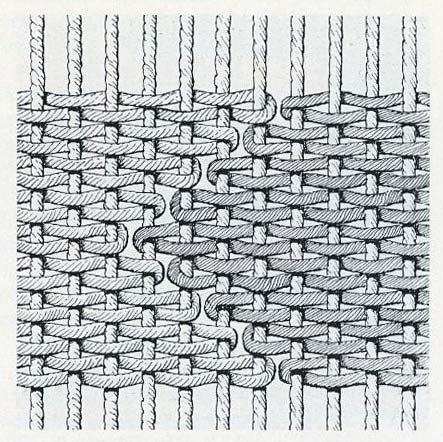
Kilim Carpet Weaving Technique Diagram
The world of antique rugs and kilims is one with a long and complex history, the fruits of which are the wonderful antique rugs and kilims that have survived over the decades and the centuries, ready to be enjoyed in homes all over the world.
Kilim Weave Techniques in Rugs and Carpets (Weft Faced Tapestry)
Kilim is the Turkish word for weft-faced tapestry, the simplest weaving structure known. It consists of vertical warps combined purely with successive passes of horizontal wefts. If the weft is compressed vertically with a weavers comb so as to cover the warps entirely, it produces ‘weft-faced’ tapestry.
By manipulating the wefts in different colors, they can be made to produce the design of the kilim rugs. Where changes in color are accomplished by vertically successive rows of diverging wefts around two adjacent warps, this produces small gaps or slits – so-called slit tapestry technique.
Alternatively the diverging wefts in different colors may stagger back and forth vertically across two adjacent warps – so-called dovetail tapestry.
Collecting Antique Kilims from All Major Producing Countries
Collecting Kilims have had their ups and downs in the rug market. Once upon a time they were considered unfit for export. More a utilitarian item of daily life than a folk craft practiced for commercial profit, kilims had always been intended for domestic use rather than sale in foreign lands. The few fragmentary pieces that arrived in the West were used as wrappings to bail pile rugs.
But as Westerners interested in Oriental rugs began to travel more in Turkey and the Caucasus, kilims gradually became known to collectors in Europe and America, and eventually they came to be appreciated for the masterpieces of village weaving that they are. Though produced in a simpler flatwoven tapestry technique, antique kilims represent an impressive rage of designs from the very small to the monumental (nos. 699, 3402, and 489).
For sheer graphic force and quality of color, nothing can beat a good antique Turkish or Anatolian kilim. The only antique pile rugs that achieved such effects are the most sought after types of or the best Turkish village rugs.
Eventually the humble status of kilims as domestic utilitarian pieces ceased to be seen as a drawback, and instead it became the very reason for collecting them. As pieces that presumably took no account of the marketplace, kilims were deemed to be absolutely authentic works of tribal textile art.
They were considered to be documents of a timeless tradition of tribal design unaffected by the influence of high art or foreign culture. Owing largely to the researches of archaeologist James Mellaart at the site of Catal Huyuk in Central Turkey, a theory evolved asserting that Anatolian kilims represent an atavistic design tradition reaching back uninterrupted all the way to the Late Stone Age, long antedating the arrival of the Turks in Anatolia. As vestiges of primordial tribal art, kilims bagan to command unprecedented prices, as they reigned supreme among collectors of tribal and village rugs.
In due course the dust settled, and the weaknesses of this theory began to be apparent. Designs claimed to be abstract representations of some ancient “mother goddess” could be more readily explained as adaptations of floral patterns in Ottoman velvet, or as simplifications of pile rug medallion designs, none of which were any older than the sixteenth century.
In fact, many of the geometric motifs in kilims – hooked or “ramshorn” motifs and serrated medallions or “ashiks” could be considerably older than this, but they are part of the authentic old repertory that the Turkic peoples brought with them into the Middle East between the tenth and thirteenth centuries, not some indigenous Anatolian tradition going back to Neolithic Catal Huyuk.
Today it is once again possible to get past all the romantic hype about timeless design in order to appreciate the power and beauty of kilims in their own right. Several examples from the Nazmiyal Collection offer some representative examples. No 699 is a Konya kilim from central Turkey or Anatolia dateable to the mid nineteenth century or earlier. The hand woven Kilim area rug is made in two separate halves (once sewn together) owing to the limited size of the looms available to the weavers.
The field is organized in horizontal bands alternating narrow and broad. The broad bands have grand hexagonal medallions with hooked or ramshorn finials and interior ashik embellishment. The narrow bands have smaller hexagons with cruciform elements. The side borders consist of hooked motifs, while the upper and lower borders have a disjointed vinescroll border of z-shaped flowers and stems. The crenellated edges that separate the border from the field are actually a technical expedient. The slit-tapestry technique has vertical openings or gaps between adjacent areas with different colors, so vertical divisions between colors must be limited in length. Long verticals must shift and meander in the form of crenellations.
Although the piece is perhaps a century and half old or more, the design tradition it represents is probably close to a thousand years old if not older, and that is quite respectable enough. But it is not the age of the design that is so attractive to us; it is the power of the dynamic drawing with bold jutting forms that rock and roll across the surface, as well as the marvelous sense of color.
Individually the various reds and greens, oranges, tans, and browns all demonstrate the quality of the dyes that Anatolian weavers had at their disposal. But the collective effect of these colors in complementary juxtaposition is simply superb, especially given the grand scale of the piece.
The weavers of these kilims knew quite well how pleasing the effects of color could be, and at times they simply ran with it in place of detailed patterning, as in Nazmiyal 489. Here the design is minimalist in the extreme – two panels of green flanking one in terracotta, with the vertical edges articulated this time as zig-zag crenellations. No less than seven or eight variegated shades of green, blue and yellow comprise the green area, with about five shades making up the terracotta.
A few horizontal stripes add the hint of a border above and below. The pleasure that this piece affords the viewer, simply in terms of the richness and variation of the color and the synergy between the terracotta and green, is nothing less than remarkable.
It is hardly surprising that kilims of this kind remain a major concern for collectors who appreciate works of genuine artistic quality and honesty. But the geometric simplicity and boldness of these pieces is also strikingly modern.
As such antique Anatolian kilims make superior as decorative furnishings in contemporary settings. Whatever our motives for acquiring them, whether as collectible pieces or as components of interior décor, antique Anatolian kilims are guaranteed to provide no end of enjoyment for their owners.
Collecting Antique Kilim Rugs That Are Caucasian and Persian
Nineteenth century kilims with allover shield medallion designs are not uncommon, though some examples are simpler than others. More graphic patterning identifies Northwest Persian kilims, which are more tribal. This identification is also supported by the reciprocal diamond border, which is distinctly Persian.
The very fine crenelation that articulated all the edges of the shield motifs is Persian as well. It is instructive to compare this example to the previous one to get a sense of how Persian and Caucasian or Anatolian kilims have a common design repertory, but one that has diverged or differentiated into highly distinctive dialects over time.
Nazmiyal kilim 3406 takes us into a very different world. This is a nineteenth century Persian kilim from the Zagros region in Southwest Persia. The recognizably floral design reflecting pile rug models indicates further that it is a Bakhtiari kilim, for only this group produced such flat-woven versions of pile designs, instead of sticking to the distinctive and independent geometric repertoire evident in virtually all other kilims.
This piece is notable not only for the more complex detailing of the floral components, but also for its extraordinary use of rich, saturated color in a wide range of shades. The contrast between the elaboration of the field and the simplicity of the zig-zag border is also quite effective.

Vintage Swedish Kilim by Ana Joanna Angstrom
Two more antique rugs – Qashgahii kilims, also from the Zagros region – will serve to round out this brief survey. The first one has a field design of concentric squares in shades of deep red and green. This simple and graphic design is elaborated further by the addition of weft float embroidery to produce the finer diamond meshes in blue and orange.
The border supplies an added contrast to the broad swaths of color in the field by effecting a barber pole design with many-colored stripes. 42234 plays with similar ideas but in a different way.
The many-colored zig-zags along the edge of the field are boldly graphic, but again they are set off against the finely detailed diamond mesh of weft-float embroidery that creates a border of sorts, and also against the little weft-float diamond medallion at the center of the otherwise open tan field.
The extensive use of weft-float embellishment is unusual. It is not widespread in Turkish kilims, or in those of the Caucasus, but this technique is typical of Turkoman and Baluch kilims from eastern Iran and central Asia. The precise connection between these and Qashgahi kilims is as yet unclear.
Kilim rugs are a recurring trend that withstood the test of time
Kilim rugs are a type of handmade flat-woven carpet that are characterized by the absence of piles or knotted fluff. Although the word is of Turkish origin, this type of rug has been traditionally made in many different regions around the world, including Turkey, Persia, Afghanistan, Pakistan, China, Morocco, the Balkans and most notably Scandinavia. See our Scandinavian Rugs.
The technique of making textiles using looms is believed to have originated thousands of years ago. The earliest known drawing of a loom is on a bowl from ancient Egypt. The bowl dates back to 4,000 BC. The loom, however, is thought to have been invented much earlier. In fact, the first looms were probably invented at the dawn of human civilization, which is believed to be between 10,000 BC and 20,000 BC. Handmade rugs are still made from looms today, different from hand-knotting, but utilizing the same techniques as ancient carpet makers.

Two Egyptian women weaving on a vertical loom
Carpets and rugs appeared much later than other kinds of fabrics. In the book “KILIM, The Complete Guide,” co-authored by Alastair Hull and Jose Luczyc-Wyhowska, the authors have stated that the flat-weave technique probably began at about 1,000 BC, based on the discovery in Fostat, Egypt of flat-woven textiles that date back to from the seventh to the eleventh century BC. This traditional technique was used to design many other rugs, such as traditional rugs.
However, Peter Davies has written in his book “The Tribal Eye: Antique Kilims of Anatolia” that flat weaving techniques seem to have entered Egypt from Syria, and not the other way round. Citing author E.J.W. Barber’s authoritative book “Prehistoric Textiles,” he states that managed flocks of sheep suitable for wool production did not appear until the third or fourth century BC, meaning that kilims could not have been made before that time.
Experts believe that the specimens found at the site of the ancient Phrygian City of Gordion in Anatolia, in present day Turkey, are the earliest examples of true kilim rugs because they are made using advanced flat-weave technique. These specimens date back to the 4th century AD, indicating that kilims originated in Anatolia. Vintage Traditional Tabriz rugs closely replicate these antique rug designs.
A piece of kilim rugs history was discovered by explorer Mark Aurel Stein in Hotan, China dating back to the 4th century AD seems to prove this theory. Remarkably, its weave is almost identical to the weave of modern day kilims, indicating that the technique of making kilim rugs was already well developed at that time and that the technique of vintage kilim rugs has changed little over the centuries.
Antique kilims found in Iran, Morocco, Scandinavia, and China prove that the flat-weaving technique spread far. Kilims are especially popular in rug-weaving centers with warm climates, where shaggy rugs were not needed to keep warm. Read about our pile rugs and knotted carpets. In addition to floor coverings, vintage kilims are used as wall insulation, bedding, clothing, and even made into saddle bags and horse covers. The strength and versatility of woolen kilims has made them valuable commodities to both nomadic tribes people and settled cultures. In addition to their practical uses, modern kilims are now prized for their decorative purposes.

